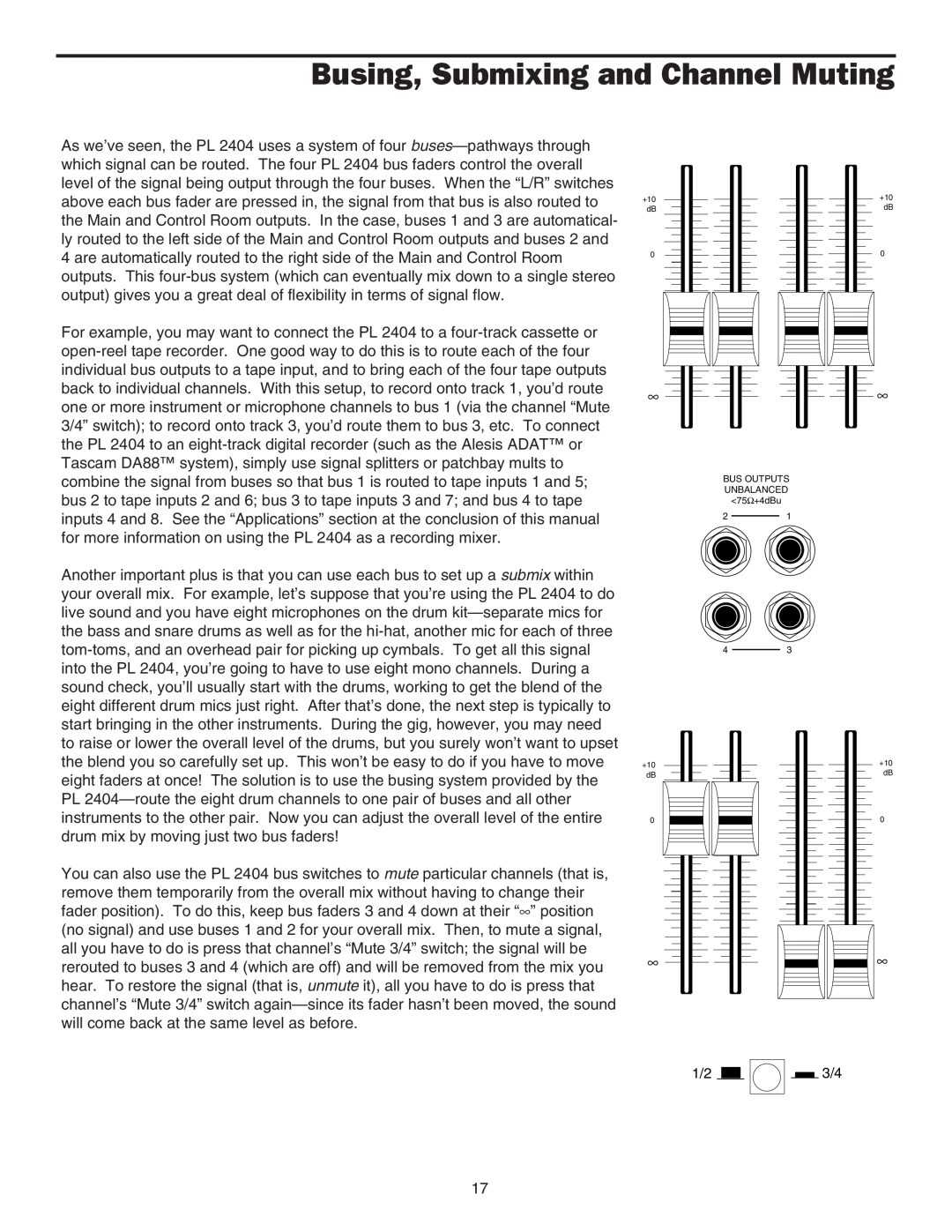As we’ve seen, the PL 2404 uses a system of four buses—pathways through which signal can be routed. The four PL 2404 bus faders control the overall level of the signal being output through the four buses. When the “L/R” switches above each bus fader are pressed in, the signal from that bus is also routed to the Main and Control Room outputs. In the case, buses 1 and 3 are automatical- ly routed to the left side of the Main and Control Room outputs and buses 2 and 4 are automatically routed to the right side of the Main and Control Room outputs. This four-bus system (which can eventually mix down to a single stereo output) gives you a great deal of flexibility in terms of signal flow.
For example, you may want to connect the PL 2404 to a four-track cassette or open-reel tape recorder. One good way to do this is to route each of the four individual bus outputs to a tape input, and to bring each of the four tape outputs back to individual channels. With this setup, to record onto track 1, you’d route one or more instrument or microphone channels to bus 1 (via the channel “Mute 3/4” switch); to record onto track 3, you’d route them to bus 3, etc. To connect the PL 2404 to an eight-track digital recorder (such as the Alesis ADAT™ or Tascam DA88™ system), simply use signal splitters or patchbay mults to combine the signal from buses so that bus 1 is routed to tape inputs 1 and 5; bus 2 to tape inputs 2 and 6; bus 3 to tape inputs 3 and 7; and bus 4 to tape inputs 4 and 8. See the “Applications” section at the conclusion of this manual for more information on using the PL 2404 as a recording mixer.
Another important plus is that you can use each bus to set up a submix within your overall mix. For example, let’s suppose that you’re using the PL 2404 to do live sound and you have eight microphones on the drum kit—separate mics for the bass and snare drums as well as for the hi-hat, another mic for each of three tom-toms, and an overhead pair for picking up cymbals. To get all this signal into the PL 2404, you’re going to have to use eight mono channels. During a sound check, you’ll usually start with the drums, working to get the blend of the eight different drum mics just right. After that’s done, the next step is typically to start bringing in the other instruments. During the gig, however, you may need to raise or lower the overall level of the drums, but you surely won’t want to upset the blend you so carefully set up. This won’t be easy to do if you have to move eight faders at once! The solution is to use the busing system provided by the PL 2404—route the eight drum channels to one pair of buses and all other instruments to the other pair. Now you can adjust the overall level of the entire drum mix by moving just two bus faders!
You can also use the PL 2404 bus switches to mute particular channels (that is, remove them temporarily from the overall mix without having to change their fader position). To do this, keep bus faders 3 and 4 down at their “∞” position (no signal) and use buses 1 and 2 for your overall mix. Then, to mute a signal, all you have to do is press that channel’s “Mute 3/4” switch; the signal will be rerouted to buses 3 and 4 (which are off) and will be removed from the mix you hear. To restore the signal (that is, unmute it), all you have to do is press that channel’s “Mute 3/4” switch again—since its fader hasn’t been moved, the sound will come back at the same level as before.

